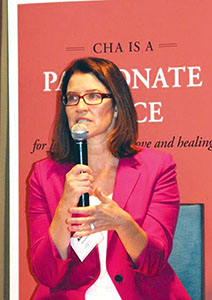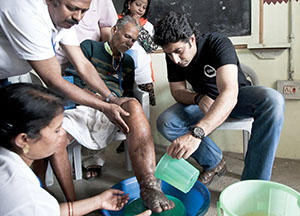By NANCY FRAZIER O'BRIEN
"Partnership" was the word on everyone's lips at CHA's 2014 Global Summit, held Sept. 16-17 in Crystal City, Va., just outside of Washington, D.C.
Speakers and participants from around the world shared ideas about how to best partner with the U.S. government, private foundations, other Catholic organizations and one another in their ministry to the poor and disadvantaged overseas.
"Our common values and common vision go a very long way in what we can achieve together," said Carolyn Woo, president and chief executive officer of Catholic Relief Services, who joined in a facilitated dialogue with Sr. Carol Keehan, DC, CHA president and chief executive officer, about the Catholic response in low-income countries.
The Catholic Church "has a natural instinct for building institutions, but not a natural instinct for collaboration," Woo said, eliciting chuckles from the audience. "But without collaboration, we will not have impact, we will not have sustainability, we will not have scale."
Church activism
Sr. Carol said the January dedication of St. Francis de Sales Hospital in Port-au-Prince, Haiti, will showcase the first major building project completed since the earthquake in Haiti five years ago and represents "the finest example of church working together.

Alexia Kelley, president and chief executive of Foundations and Donors Interested in Catholic Activities, tells summit participants that some members of her organization concentrate their international health funding in sanitation, maternal health, children’s health and early childhood development.
"There are other places that we can do these same kinds of things," she said. Sr. Carol called for political collaboration to fight the effects of brutal dictatorships and of global warming on the world's poor: "Keeping silent when whole segments of the population are marginalized and (dictators) are allowed to run rampant can undo all the good we do."
Auxiliary Bishop Glandas Marie Erick Toussaint of Port-au-Prince, general director of St. Francis de Sales Hospital, attended the summit and thanked the U.S. Catholic community for its help in building a state-of-the-art health care campus that will serve all of Haiti, replacing an aging hospital that was destroyed in the quake.
"It's been 124 years since that hospital started and with the support of CHA and CRS we will move forward toward 130 years, 150 years and even 200 years," he said through a translator.
Private development
Participants in the global summit also heard from representatives of the U.S. Agency for International Development, the Bill and Melinda Gates Foundation, Foundations and Donors Interested in Catholic Activities, the Global Network for Neglected Tropical Diseases and several Catholic health systems that are in various phases of involvement with global health projects.
Margaret Sullivan, USAID chief of staff, said the agency can "actually see light at the end of the tunnel" toward the first Millennium Development Goal of ending extreme poverty, which is defined as people living on less than $1.25 a day.
Although approximately 1.1 billion people worldwide still live in extreme poverty, Sullivan said, that represents nearly 700 million fewer people than were living in that state in 1990. "The modern world has the capability to change this if it really sets its mind to it," she added.
Noting that "90 percent of the money that flows into developing countries now comes from private capital sources," Sullivan said USAID has had to adapt to "a tremendous evolution in the landscape in terms of the types of players drawn to development." New technology also is driving innovation in the development field, she said, describing an app that allows a smartphone to function as a microscope that can aid in remote diagnosis of a number of basic diseases that "we know how to treat if we know a person is suffering from it."
Willing partners
J. Mark Brinkmoeller, director of the USAID Center for Faith-Based and Community Initiatives, introduced a panel of three USAID staff members — Dr. Jennifer Adams, deputy assistant administrator of the USAID Bureau for Global Health; Brian Cognato, program operations specialist in the USAID Office of American Schools and Hospitals Abroad; and Dr. Susan Thollaug, team leader of the health group in the USAID Bureau for Latin America and the Caribbean — who offered suggestions for strengthening ties between the government agency and Catholic-led initiatives overseas.

Electricians install hall lights at St. Francis de Sales Hospital in Port-au-Prince, Haiti. The facility, which will be dedicated in January, was built through a collaboration between Catholic Relief Services, the Archdiocese of Port-au-Prince and the Catholic health ministry.
"We are adapting to the fact that we are not the big gorilla on the block anymore in terms of foreign aid," Thollaug said. "We're learning how to partner, and CHA has a lot of expertise to bring to the table as we do this."
Pam Smith, deputy director of U.S. government relations for the Bill and Melinda Gates Foundation and a former CHA staff member, then outlined the funding priorities for the foundation, which provides more than $3.1 billion annually in the fields of global health, global development and U.S. education.
She said the foundation is "not out there running programs" but provides funding to organizations like those represented at the summit and "engages with the government and the public and private sector to encourage robust funding and to get people to care about our issues."
Although there are many challenges and it is "easy to get overwhelmed and discouraged," Smith said there are many signs of progress in global health. Childhood deaths are declining worldwide; "we're on track to eradicate polio by 2018," and the price of treating HIV is falling, she said.
Concentrated investment
Alexia Kelley, president and chief executive of Foundations and Donors Interested in Catholic Activities, said the 50 foundations and individual members she represents do not all fund international projects but those that do have been focusing on sanitation, maternal health, children's health and early childhood development.
Dr. Neeraj Mistry, managing director of the Global Network for Neglected Tropical Diseases, described a program to eradicate the seven most common neglected tropical diseases by 2020. The diseases, which include roundworm, hookworm, lymphatic filariasis and several diseases affecting eyesight, can be treated at the community level at a cost of about 50 cents a day per person for a year's worth of protection, he said.
Mistry said faith-based organizations can help in the fight by encouraging healthy behaviors in affected communities, by supporting resource mobilization to fund preventive measures and by "tackling the stigma and discrimination" of these diseases. "It is through changing social perception that we ultimately change policy and programs," he added.
Short-term medical missions
The summit also marked the unveiling of a new CHA-sponsored research study into the effectiveness of short-term medical mission trips (see story, below).

Abhishek Bachchan, a Bollywood star and END7 campaign ambassador, washes the foot of a man with lymphatic filariasis at a community clinic in Odisha State, India. END7 is an international advocacy campaign to eradicate lymphatic filariasis and six other common diseases that is run by the Global Network for Neglected Tropical Diseases, an initiative of the Sabin Vaccine Institute.
Three summit participants closed the meeting with reports on their own health systems' involvement in global health.
Martin Schreiber, system director of mission physician services/global ministry for Chicago-based Presence Health, said his system is in the process of discerning its entry into global mission and met May 29 to discuss such issues as cultural competency, ways to strengthen partnerships and how to allow the community being served to determine its own needs.
Michael J. Hibbard, vice president of clinical solutions-IT for Cincinnati-based Mercy Health (formerly Catholic Health Partners), said his organization is working in Guyana and Haiti, "not to replace the good work that people are doing" but to find a centralized approach to meeting some of the populations' needs.
Aimee Khuu, director of Providence Health International for Renton, Wash.-based Providence Health & Services, said the system is working in eight villages in the central highlands of Guatemala to improve community health by giving every mother access to health care, education and support and by providing a latrine, a stove, clean water and a hand-washing station in every home.
She said the 72,000-employee Providence system has a waiting list of 700 people for its service trips to Guatemala.
"We're engaging the system at all levels," Khuu said. "Every department has something to contribute to this work."
Study seeks best practices on short-term medical mission trips The greatest challenges to effective short-term medical mission trips are funding, sustainability and coordination of effort, according to a new research study sponsored by CHA. Judith Lasker, a professor of sociology at Lehigh University, and Fr. Michael Rozier, SJ, a doctoral student in the Department of Health Management and Policy at the University of Michigan, reported on the first phase of the study findings Sept. 17 at the CHA 2014 Global Summit in Crystal City, Va. Lasker acknowledged that short-term medical mission trips are a "contentious area," with some who "believe short-term volunteering is a wonderful thing and others who think it is a terrible thing. "There are wonderful stories of lives saved, but there is also a huge amount of criticism that these trips do not accomplish what they intend to and might have unintended consequences," she added. The second phase of the research study will assess the impact of the trips on the host communities and suggest best practices for the future. Bruce Compton, CHA's senior director of international outreach, said the goal of the study "is not to endorse or not endorse doing short-term mission work" but to provide information on "how to do it best." The study data was collected through an online survey of Catholic hospitals and health systems that was open to anyone who had participated in or overseen a short-term medical mission trip in the past five years. Because the survey was forwarded to others outside the Catholic systems, CHA member organizations sponsored only about 40 percent of the trips reported on by the respondents. Lasker said the more than 500 responses received likely represent "the largest existing data set on short-term medical missions." In addition, the researchers conducted 18 in-depth interviews with a cross section of survey respondents. Survey participants were asked to report on all mission trips taken in the past five years and on their most recent trip. The most recent trips reported on included some 2,300 volunteers traveling to 45 countries at an estimated cost of $3.45 million. Only about a quarter of the money remained in the host country, with a large portion of the total funding spent on air travel. The study found "significant gaps" between what respondents reported as their actual experience and what they envisioned as an "ideal" mission trip: - While most trips accepted anyone who volunteered, most organizers wanted to be able to exclude those who were unwilling to learn from the host community, noncompliant with the rules or who have physical or mental health issues.
- Although orientation generally lasted only one or two hours or was conducted online, respondents said orientation should last at least half a day and should include more preparation in cultural competence, country history, language and specific skills needed for the trip.
- Most trips lasted one week or less, but most participants believe the trips should last longer.
The phase one recommendations said "longer stays and more frequent returns to the same place make it possible to know what to expect, develop relationships and have continuity of care." Among the study's other recommendations, hospitals or health systems should: - Consider how to target material or financial resources to fewer, well-run efforts rather than spreading resources across many projects.
- Describe host communities as "hosts" or "partners" rather than "recipients" or "beneficiaries." The latter terminology can "inadvertently undermine the goal of a mutual partnership, reinforce stereotypes of superiority and inferiority, and make assumptions about whether people are truly benefitting," the report said.
- Screen volunteers for the skills needed by host communities, their adaptability to the medical mission trip experience and their ability to cooperate in a team and respect the host community members.
- Consider how medical mission activities might cause unintended harm to the host community. "For example, patient medications given to a family with small children without childproof containers can be more harmful than no medication at all.
In short-term medical missions," the report said, "something can actually be worse than nothing." |